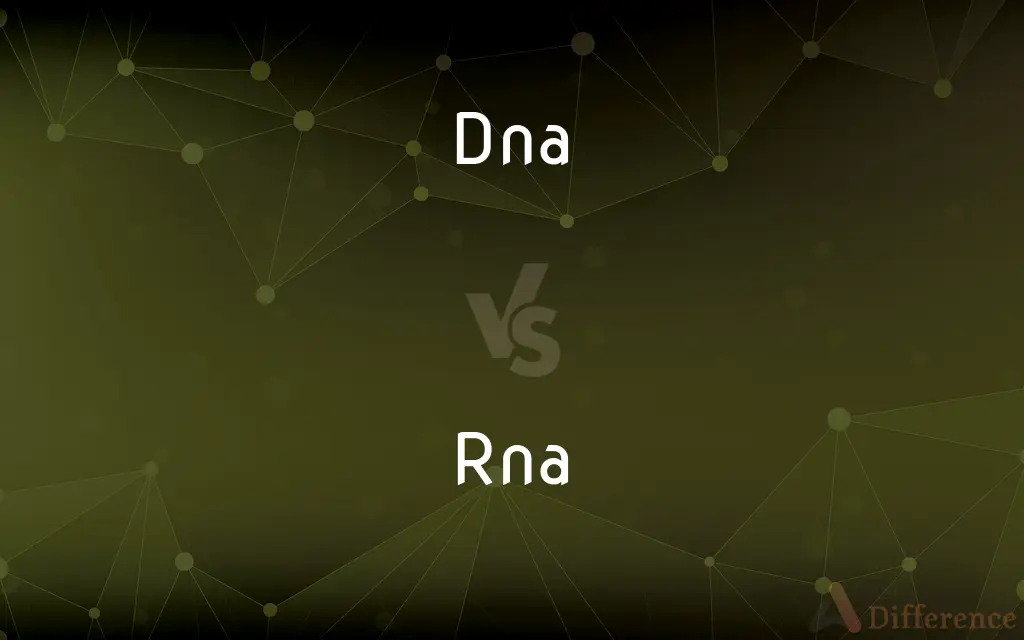DNA vs. RNA — What's the Difference?
By Tayyaba Rehman — Updated on September 21, 2023
DNA contains genetic instructions for organisms, with a double helix structure; RNA transfers genetic information and is typically single-stranded.

Difference Between DNA and RNA
Table of Contents
ADVERTISEMENT
Key Differences
DNA, or Deoxyribonucleic acid, is the molecule that carries the genetic code for all living organisms. RNA, or Ribonucleic acid, on the other hand, acts primarily to transfer the genetic information contained within DNA to the cellular machinery that produces proteins.
DNA possesses a stable, double-helix structure, forming a twisted ladder-like shape. RNA is usually single-stranded and can assume various shapes, giving it versatility in its function and role in protein synthesis.
DNA resides mainly in the cell nucleus in eukaryotic organisms. RNA, once synthesized using DNA as a template, often travels out of the nucleus into the cell's cytoplasm, where it plays its part in the process of protein synthesis.
The building blocks of DNA include four bases: adenine, thymine, cytosine, and guanine. In RNA, thymine is replaced by uracil, making the four bases adenine, uracil, cytosine, and guanine.
To sum up, while DNA acts as the long-term storage for genetic information, RNA serves as the messenger that carries this information to where it's needed for the creation of proteins and other functions.
ADVERTISEMENT
Comparison Chart
Primary Role
Stores genetic information
Transfers genetic information for protein synthesis
Structure
Double-helix
Typically single-stranded
Location in Eukaryotes
Primarily in the cell nucleus
Moves from nucleus to cytoplasm
Bases
Adenine, Thymine, Cytosine, Guanine
Adenine, Uracil, Cytosine, Guanine
Sugar
Deoxyribose
Ribose
Compare with Definitions
Dna
The blueprint for building and maintaining an organism.
Mutations in DNA can lead to genetic disorders.
Rna
Typically a single-stranded structure.
RNA's structure allows it to perform various functions.
Dna
A double-stranded helix structure.
The unique shape of DNA was first described by Watson and Crick.
Rna
A molecule that carries genetic information for protein synthesis.
RNA is synthesized in the nucleus and works in the cytoplasm.
Dna
The molecule containing the genetic code of organisms.
The DNA of identical twins is remarkably similar.
Rna
Plays a role in translating DNA's information.
MRNA, a type of RNA, carries genetic codes from DNA to ribosomes.
Dna
The hereditary material in humans and other organisms.
DNA testing can confirm familial relationships.
Rna
Contains the nucleotide base uracil instead of thymine.
The base pairing in RNA involves adenine with uracil.
Dna
Composed of four nucleotide bases: A, T, C, G.
The sequence of DNA determines genes and traits.
Rna
Involved in various cellular processes beyond protein synthesis.
RRNA and tRNA are essential types of RNA for protein assembly.
Dna
Deoxyribonucleic acid, a self-replicating material which is present in nearly all living organisms as the main constituent of chromosomes. It is the carrier of genetic information.
Rna
Ribonucleic acid, a nucleic acid present in all living cells. Its principal role is to act as a messenger carrying instructions from DNA for controlling the synthesis of proteins, although in some viruses RNA rather than DNA carries the genetic information.
Dna
A nucleic acid that carries the genetic information in cells and some viruses, consisting of two long chains of nucleotides twisted into a double helix and joined by hydrogen bonds between the complementary bases adenine and thymine or cytosine and guanine. DNA sequences are replicated by the cell prior to cell division and may include genes, intergenic spacers, and regions that bind to regulatory proteins.
Rna
A nucleic acid present in all living cells and many viruses, consisting of a long, usually single-stranded chain of alternating phosphate and ribose units, with one of the bases adenine, guanine, cytosine, or uracil bonded to each ribose molecule. RNA molecules are involved in protein synthesis and sometimes in the transmission of genetic information. Also called ribonucleic acid.
Dna
Alternative form of DNA
Rna
(biochemistry) a long linear polymer of nucleotides found in the nucleus but mainly in the cytoplasm of a cell where it is associated with microsomes; it transmits genetic information from DNA to the cytoplasm and controls certain chemical processes in the cell;
Ribonucleic acid is the genetic material of some viruses
Dna
Abbreviation for deoxyribonucleic acid; - more commonly used than the full name. See also RNA.
Dna
(biochemistry) a long linear polymer found in the nucleus of a cell and formed from nucleotides and shaped like a double helix; associated with the transmission of genetic information;
DNA is the king of molecules
Common Curiosities
What's the primary function of RNA?
RNA primarily transfers genetic information for protein synthesis.
Is DNA always double-stranded?
Typically, yes, DNA is double-stranded forming a double helix.
What does DNA stand for?
DNA stands for Deoxyribonucleic Acid.
Can RNA form structures other than single strands?
Yes, RNA can fold into complex structures essential for its functions.
Which base is present in RNA but not in DNA?
Uracil is present in RNA, replacing thymine from DNA.
Share Your Discovery

Previous Comparison
Promyelocyte vs. Myelocyte
Next Comparison
Hegemony vs. IdeologyAuthor Spotlight
Written by
Tayyaba RehmanTayyaba Rehman is a distinguished writer, currently serving as a primary contributor to askdifference.com. As a researcher in semantics and etymology, Tayyaba's passion for the complexity of languages and their distinctions has found a perfect home on the platform. Tayyaba delves into the intricacies of language, distinguishing between commonly confused words and phrases, thereby providing clarity for readers worldwide.














































